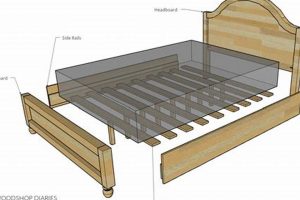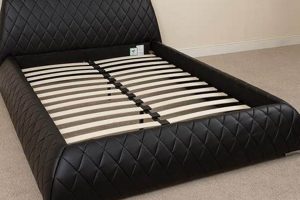A supportive structure designed to elevate and encase an inflatable sleeping surface, enhancing its stability and user experience. For example, a metal frame with a slatted base provides a more rigid and level foundation compared to placing the inflatable directly on the floor.
The implementation of such a support system elevates the inflatable off the ground, mitigating temperature loss and exposure to dirt or potential punctures. Historically, makeshift platforms were utilized for similar purposes; however, purpose-built solutions offer improved ergonomics, aesthetics, and long-term durability. These platforms address the inherent instability of inflatable surfaces, improving the overall quality of rest.
The following sections will explore various types of these structures, their respective advantages and disadvantages, and factors to consider when selecting an appropriate model for a specific inflatable sleeping surface.
Tips for Selecting an Inflatable Mattress Support Structure
Choosing the correct support structure for an inflatable mattress significantly improves its stability, longevity, and user comfort. Careful consideration of several factors ensures optimal performance and value.
Tip 1: Measure the Inflatable Mattress Dimensions: Precise measurements of the inflated mattresss length, width, and height are crucial. The support structure must adequately accommodate these dimensions to prevent overhang or instability.
Tip 2: Assess Weight Capacity: Determine the maximum weight the support structure needs to bear. Consider the weight of the mattress itself plus the anticipated weight of the occupant(s). Exceeding the rated capacity can lead to structural failure.
Tip 3: Evaluate Material Durability: The materials used in the support structure should withstand repeated use and stress. Steel or reinforced wood frames offer enhanced durability compared to lightweight plastic alternatives.
Tip 4: Consider Storage Requirements: If portability and storage are paramount, opt for a foldable or collapsible support structure. These designs facilitate convenient transportation and space-saving storage when not in use.
Tip 5: Examine Frame Height: The height of the support structure affects ease of access and overall bed height. Lower frames may be suitable for individuals with mobility limitations, while taller frames may be preferred for aesthetic reasons or storage underneath.
Tip 6: Evaluate Stability Features: Look for support structures with features that enhance stability, such as non-slip surfaces, locking mechanisms, or adjustable legs. These features minimize movement and prevent the mattress from shifting during use.
Tip 7: Check Compatibility with Bedding: Ensure the support structure is compatible with standard bedding sizes. Using appropriately sized sheets, blankets, and comforters contributes to a neat and comfortable sleep environment.
Proper selection of a support structure enhances comfort, improves mattress longevity, and provides a more stable sleep surface. Attention to weight capacity, dimensions, and storage needs will assist in making an informed purchase.
The following sections will address specific use cases and common problems associated with inflatable mattress support structures, providing guidance for troubleshooting and maintenance.
1. Stability
Stability, in the context of inflatable mattress support structures, refers to the resistance to movement, wobbling, or collapse of the entire system comprising the inflatable mattress and its supporting platform. It is a primary determinant of user comfort and safety.
- Distribution of Weight
An appropriately designed support structure evenly distributes the weight of the occupant across the entire surface area of the inflatable mattress. This prevents localized stress concentrations that could lead to deformation or failure of the inflatable material. Uneven weight distribution compromises stability, resulting in a rocking or tilting sensation.
- Rigidity of the Frame
The material and construction of the support structure significantly impact its rigidity. Steel or reinforced wood frames provide greater resistance to bending and twisting compared to lightweight plastic or flimsy metal alternatives. A rigid frame maintains a level plane, minimizing movement and enhancing the perceived stability of the inflatable mattress.
- Surface Friction
The friction between the inflatable mattress and the surface of the support structure influences stability. Slippery surfaces allow the mattress to shift during use, compromising balance and potentially leading to falls. Non-slip materials or textured surfaces increase friction, preventing unwanted movement and enhancing overall stability.
- Footing and Ground Contact
The design and placement of the support structure’s legs or feet determine its stability on various floor surfaces. Wide, stable feet provide a larger contact area, reducing the likelihood of tipping or wobbling. Adjustable feet allow for leveling on uneven surfaces, ensuring consistent stability regardless of the floor conditions.
The aforementioned facets of stability are interdependent and collectively contribute to the overall performance of inflatable mattress support structures. Compromises in any of these areas can negatively impact user comfort, safety, and the longevity of the inflatable mattress itself. Therefore, careful consideration of these factors is paramount when selecting an appropriate supporting system.
2. Support
Adequate support is a critical function of a bed frame designed for inflatable mattresses, influencing both user comfort and the lifespan of the inflatable itself. The bed frame’s ability to provide consistent and even support directly translates to a more restful sleep experience and reduces the likelihood of material fatigue in the inflatable mattress.
- Weight Distribution
The primary function of the support structure is to distribute the occupant’s weight evenly across the inflatable mattress surface. Without adequate support, localized pressure points can develop, leading to discomfort and accelerated wear on the inflatable material. A well-designed frame mitigates this issue by providing a consistent foundation.
- Prevention of Sagging
Inflatable mattresses, by their nature, are prone to sagging, particularly in the center. A robust bed frame with appropriate center support prevents excessive sagging, maintaining a level sleep surface. This is especially important for couples or individuals who prefer a firmer sleeping surface.
- Edge Support Enhancement
Inflatable mattresses often lack adequate edge support, making it difficult to sit or sleep near the edges without experiencing a feeling of rolling off. A bed frame with reinforced edge support provides a more stable perimeter, increasing the usable sleep surface and enhancing overall comfort.
- Protection from Punctures
Elevating the inflatable mattress off the floor protects it from potential punctures caused by sharp objects or uneven surfaces. The bed frame acts as a barrier, minimizing the risk of damage and extending the mattress’s lifespan. This is particularly crucial in environments where the floor surface is not consistently clean and smooth.
The level of support provided by a bed frame significantly contributes to the overall functionality and value of an inflatable mattress system. Considerations regarding weight distribution, sagging prevention, edge support, and protection from punctures are essential in selecting a frame that maximizes comfort, durability, and user satisfaction.
3. Durability
The durability of a support structure directly impacts the lifespan and performance of an inflatable mattress system. A frame constructed from robust materials and designed with sound engineering principles withstands repeated use, preventing premature failure and ensuring continued support. For example, a steel frame with welded joints demonstrates superior durability compared to a plastic frame with snap-fit connections, especially under consistent weight loads. The consequences of inadequate durability include frame collapse, instability, and ultimately, the inability to properly support the inflatable mattress. This compromises user comfort and necessitates replacement of the entire system, resulting in increased costs and inconvenience.
Material selection plays a critical role in determining the overall durability. Powder-coated steel offers resistance to corrosion and wear, while solid wood frames, properly treated, provide lasting strength. Conversely, lightweight aluminum or particleboard construction may exhibit weakness under stress, leading to bending, cracking, or joint separation. Design also influences lifespan; reinforced corners and cross-bracing enhance structural integrity, preventing deformation over time. Consider the experience of frequent users: frames subjected to regular assembly and disassembly, such as those used in guest rooms or temporary living arrangements, require enhanced durability to withstand the added stress.
Ultimately, durability is a key investment consideration. A higher initial cost for a more durable frame translates to long-term cost savings by minimizing the need for repairs or replacements. Ignoring durability in favor of short-term cost savings often leads to diminished performance, reduced lifespan, and a less satisfactory sleep experience. Prioritizing robust construction and quality materials ensures a stable, reliable, and long-lasting support system for an inflatable mattress.
4. Portability
The inherent design of inflatable mattresses facilitates ease of transport and storage, a characteristic often sought by individuals with limited space, frequent relocations, or a need for temporary bedding solutions. The integration of portability into the design of support structures for inflatable mattresses significantly broadens the utility of these systems. A non-portable frame negates a key advantage of the inflatable mattress itself, limiting its application to stationary settings. Conversely, a portable frame extends its usability to camping, guest accommodations, or temporary housing. The cause-and-effect relationship is direct: an inability to disassemble or easily move the support structure directly limits the inflatable mattress’s intended purpose.
The importance of portability manifests in various design adaptations. Folding mechanisms, lightweight materials such as aluminum alloys, and modular construction are common strategies employed to enhance ease of movement. For example, some models feature frames that collapse into a compact form factor, enabling convenient storage in closets or vehicle trunks. Others utilize a system of interlocking segments that can be quickly assembled and disassembled without specialized tools. The practical significance is evident in scenarios requiring rapid deployment of sleeping arrangements or where storage space is at a premium; portable frames enable swift setup and breakdown, optimizing efficiency and convenience.
Challenges associated with portable support structures include balancing lightweight construction with adequate structural integrity. Sacrificing durability for portability may compromise the stability and load-bearing capacity of the frame. However, advancements in material science and engineering design are increasingly mitigating these trade-offs. In summary, portability represents a crucial component of adaptable inflatable mattress systems, expanding their practical application and contributing to user convenience. The integration of this feature requires careful consideration of material selection, construction methods, and user needs to ensure both ease of transport and reliable support.
5. Size
The dimensional compatibility between an inflatable mattress and its corresponding support structure is paramount for stability, safety, and optimal utilization. Inaccurate sizing leads to compromised support, potential damage to the inflatable mattress, and diminished user experience. The selected frame must precisely accommodate the inflated dimensions to prevent overhang, which concentrates stress on unsupported areas, or insufficient support, which results in sagging and instability. Real-world examples demonstrate the direct correlation: an inflatable mattress exceeding the frame’s dimensions suffers edge deformation and increased risk of puncture, whereas a frame significantly larger fails to provide adequate lateral support, leading to an unstable sleep surface. The practical significance of precise sizing lies in ensuring even weight distribution, promoting mattress longevity, and enhancing sleep quality.
Specific sizing considerations encompass length, width, and height. Standard mattress sizes (Twin, Full, Queen, King) offer a convenient starting point, but actual inflated dimensions can vary between manufacturers. Pre-purchase measurement of the inflated mattress is crucial. Inadequate frame height can also impede accessibility, particularly for individuals with mobility limitations. Conversely, excessive height may create an unstable platform. Adaptable frame designs, such as adjustable models, offer a degree of flexibility, accommodating slight variations in mattress dimensions. These adjustable systems minimize the risks associated with fixed-size frames, providing a broader range of compatibility.
In summary, the dimensions of the support structure are intrinsically linked to the performance and durability of the inflatable mattress. The accuracy of the size is a critical factor to observe. Imprecise sizing undermines the stability, compromises user comfort, and potentially shortens the lifespan of the inflatable. Prioritizing dimensional compatibility ensures optimal functionality and a prolonged service life for the entire inflatable mattress system.
6. Height
The vertical dimension of a support structure significantly influences user experience, accessibility, and storage capacity relative to an inflatable mattress. Strategic consideration of height ensures compatibility with individual needs and environmental constraints.
- Accessibility and Ergonomics
Frame height dictates ease of ingress and egress. Lower frames facilitate access for individuals with mobility limitations, while elevated frames require more exertion. An appropriately chosen height minimizes strain on joints and promotes comfortable transitions to and from the sleeping surface. Examples include platforms designed for elderly users versus those intended for younger, more agile individuals. Improper height can exacerbate existing physical conditions or pose safety risks.
- Storage Capacity
Elevated frames create under-bed storage space, accommodating bedding, luggage, or other personal items. This feature is particularly valuable in compact living environments where space optimization is paramount. Frame height must be balanced against stability considerations; excessively tall frames may exhibit reduced stability compared to lower-profile alternatives. The amount of accessible storage is directly proportional to the elevation of the frame.
- Aesthetic Considerations
Frame height influences the visual profile of the bed within a room. Taller frames impart a more substantial and commanding presence, while lower frames create a minimalist aesthetic. Compatibility with existing furniture and dcor is crucial. Selecting a frame height that complements the overall design scheme enhances the room’s aesthetic appeal.
- Compatibility with Bedding
Frame height affects the required dimensions of bedding, such as bed skirts and comforters. An excessively tall frame may necessitate oversized bedding to ensure adequate coverage, while a low-profile frame may render standard-sized bedding unsuitable. Accurate measurement of frame height is essential when selecting appropriate bedding to maintain a cohesive and aesthetically pleasing appearance.
Frame height represents a critical design parameter in inflatable mattress systems. The height chosen has functional and aesthetic effects. Prioritizing height optimization ensures compatibility with individual needs, maximizes storage potential, and enhances overall integration within the surrounding environment.
Frequently Asked Questions
This section addresses common inquiries regarding support structures for inflatable mattresses, providing concise and informative answers to promote informed decision-making.
Question 1: Why is a support structure necessary for an inflatable mattress?
A support structure enhances stability, elevates the mattress off the floor (reducing temperature loss and exposure to contaminants), and distributes weight more evenly, increasing user comfort and prolonging the lifespan of the mattress.
Question 2: What types of materials are best suited for a durable support structure?
Steel, reinforced wood, and high-density polyethylene offer superior durability and load-bearing capacity compared to lightweight plastics or thin metals. Material selection should align with anticipated usage and weight requirements.
Question 3: How should one determine the appropriate size of a support structure?
Measure the fully inflated mattress dimensions (length, width, and height) and select a support structure that precisely matches these measurements. Overhang or insufficient support compromises stability and reduces mattress lifespan.
Question 4: What factors should be considered regarding the height of a support structure?
Height influences ease of access, storage capacity, and aesthetic integration within the room. Individuals with mobility limitations may prefer lower frames, while those seeking under-bed storage may opt for taller options.
Question 5: What features enhance the stability of a support structure?
Non-slip surfaces, adjustable legs, and robust frame construction contribute to enhanced stability. These features minimize movement and prevent the mattress from shifting during use.
Question 6: How does a support structure contribute to the longevity of an inflatable mattress?
By providing even weight distribution and protecting the mattress from punctures and abrasions, a support structure minimizes stress on the inflatable material, thereby extending its usable lifespan.
In conclusion, selecting a compatible support structure significantly enhances the comfort, stability, and longevity of an inflatable mattress. Careful consideration of these frequently asked questions promotes informed purchasing decisions.
The following section will provide cleaning and maintenance recommendations for both the inflatable mattress and its support structure, optimizing hygiene and preserving performance.
Concluding Remarks on Bed Frame for Air Mattress
This exploration has detailed the function and critical characteristics of a bed frame for air mattress, emphasizing the importance of stability, support, durability, portability, and appropriate sizing and height. A properly selected support structure maximizes user comfort, enhances mattress longevity, and promotes safety during use. The interdependencies between these factors underscore the necessity of a comprehensive evaluation prior to purchase.
The judicious selection and conscientious maintenance of a bed frame for air mattress represent a tangible investment in sleep quality and the sustained performance of the inflatable mattress system. Continued adherence to the principles outlined herein will yield long-term benefits and ensure optimal utilization of this adaptable bedding solution.




![Best Queen Size Bed Frame with Mattress [Deals] Organic & Natural Mattress Buyer’s Guide: Non-Toxic Sleep Solutions Best Queen Size Bed Frame with Mattress [Deals] | Organic & Natural Mattress Buyer’s Guide: Non-Toxic Sleep Solutions](https://mattressworldpa.com/wp-content/uploads/2025/07/th-3082-300x200.jpg)


